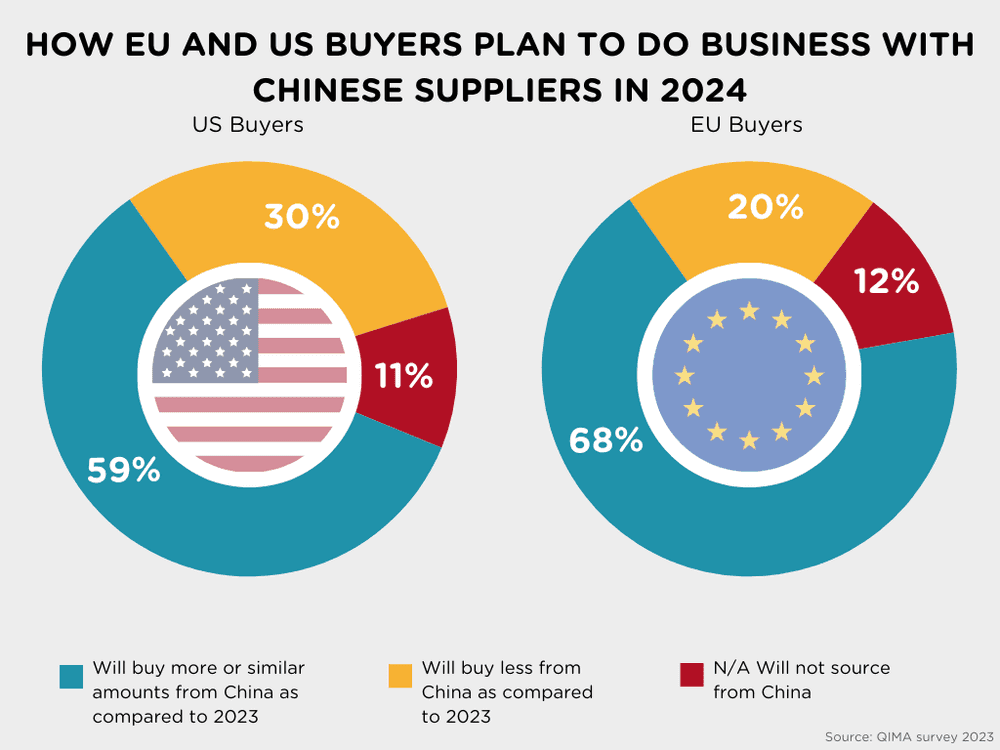
Aprovisionamiento en China está en camino a las tasas pre-pandémicas
Mientras que China fue en su momento el principal proveedor de cadenas de suministro globales, la pandemia de COVID causó que muchas empresas cambiaran sus proveedores hacia el sudeste asiático y ubicaciones cercanas. Sin embargo, una encuesta reciente de QIMA indica que están volviendo a proveedores chinos. Comprender los resultados de nuestra encuesta y cómo estas tendencias de abastecimiento impactan en las cadenas de suministro globales puede ayudarlo a tomar decisiones informadas de abastecimiento a medida que cambia el panorama de proveedores.
Donde China alguna vez tuvo un 67% de la participación relativa en volúmenes de abastecimiento para compradores de EE. UU. y la UE, los volúmenes de abastecimiento de China cayeron a un 48% en 2022. Estos cambios en las tendencias de abastecimiento vinieron con la pandemia de COVID-19 y el aumento de tensiones geopolíticas, lo que llevó a muchos compradores de EE. UU. y la UE a transitar su abastecimiento hacia proveedores del Sudeste Asiático y localizados geográficamente cercanos para reducir sus riesgos en la cadena de suministro.
Sin embargo, los datos de abastecimiento de 2023 revelan un aumento constante del abastecimiento de China, con datos que sugieren que China podría estar recuperándose de las caídas de años recientes. Los datos de QIMA, encuestados a más de 800 empresas, mostraron un notable incremento del 5,4% interanual (YoY) en la demanda de inspecciones y auditorías de compradores en EE. UU. y la UE en China.
Esta trayectoria ascendente, observada por primera vez en el barómetro T4 2023 de QIMA, marca el primer aumento en la participación de China en las carteras de proveedores de estos compradores desde 2018. Estos datos indican una confianza renovada en los proveedores chinos, resaltando su capacidad de adaptarse y recuperarse en un mundo pospandemia.
Figura 1. Mercados proveedores principales de compradores de EE. UU. y la UE (participación relativa en volúmenes de abastecimiento) El abastecimiento en China ha disminuido anualmente desde 2018, mientras que el abastecimiento en el Sudeste Asiático y el Sur de Asia ha escalado constantemente. 2023 vio el primer aumento en años recientes del abastecimiento en China, con un alza del 48% al 50%.

El futuro del papel de China en las cadenas de suministro globales
El cambio ascendente en la trayectoria de China indica su recuperación en las cadenas de suministro globales; sin embargo, esto no garantiza que vuelva a los niveles de abastecimiento prepandemia. A medida que China continúa reafirmando su posición en las cadenas de suministro globales, podría tener que competir con los mercados en crecimiento del Sudeste Asiático y la tendencia creciente de la producción local cercana.
Afortunadamente, el optimismo que rodea al abastecimiento en China está respaldado por datos adicionales que muestran un interés significativo de los países occidentales. Según una encuesta reciente de QIMA, el 59% de los encuestados de EE. UU. y el 68% de los que tienen sede en la UE planean mantener o aumentar sus volúmenes de negocio con proveedores chinos. Este fuerte interés de las principales economías globales subraya el papel fundamental de los proveedores chinos en el apoyo a cadenas de suministro globales diversas y complejas, y sugiere la recuperación de China hacia tasas de abastecimiento prepandemia.
Figura 2: Encuesta de Abastecimiento de QIMA, "¿Cuánto negocio planea realizar con proveedores chinos en 2024, en comparación con 2023?" Las encuestas muestran que la mayoría de los compradores de EE. UU. y la UE tienen la intención de continuar o aumentar sus hábitos de compra de China, lo que indica el continuo crecimiento del abastecimiento chino de compradores extranjeros.

Aunque las tendencias de 2023 pintan un panorama prometedor para el papel recuperado de China en la economía global, las empresas deben seguir siendo conscientes del panorama geopolítico actual y sus posibles implicaciones. El 2024 podría representar un año difícil para los proveedores basados en China, ya que las tensiones políticas de las elecciones presidenciales estadounidenses podrían impactar significativamente las relaciones comerciales entre EE. UU. y China. Este aspecto geopolítico podría jugar un papel decisivo en dar forma al futuro del abastecimiento de proveedores chinos.
Figuras clave
Datos de QIMA revelan:
El abastecimiento en China está en ascenso por primera vez en años: La participación relativa de China en las carteras de proveedores de EE. UU. y la UE aumentó un 5,4% interanual en 2023, mostrando el primer incremento en cinco años.
Es probable que el uso del abastecimiento chino aumente en 2024: Más de la mitad (59%) de los compradores en EE. UU. y (68%) de los compradores en la UE planean aumentar o mantener sus hábitos de compra actuales con China, mientras que solo el 30% de los compradores en EE. UU. y el 20% de los compradores en la UE tienen la intención de reducir su abastecimiento en China.
Leer el informe completo: Q1 2024 Barómetro
Related Articles


